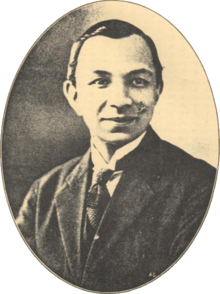Robert Kotewall (original) (raw)
From Wikipedia, the free encyclopedia
| Robert Kotewall | |
|---|---|
 Robert Kotewall Robert Kotewall |
|
| Senior Unofficial Member of the Executive Council | |
| In office1946 | |
| Governor | Cecil Harcourt |
| Preceded by | John Johnstone Paterson |
| Succeeded by | Arthur Morse |
| Personal details | |
| Born | Robert Hormus Kotewall1880 (1880) |
| Died | 23 May 1949British Hong Kong |
| Spouse | Edith Kotewall (nee Lowcock) |
| Occupation | Businessman |
| Robert Kotewall | |
|---|---|
| Traditional Chinese | 羅旭龢 |
| TranscriptionsYue: CantoneseYale RomanizationLòh, Yūk-wòhJyutpingLo4, Juk1wo4 | |
Sir Robert Hormus Kotewall CMG (羅旭龢; 1880–1949) was a British Hong Kong businessman, civil servant and legislator.
Kotewall was born in 1880. He was the son of Hormusjee Rustomjee Kotewall, an Indian Parsi, and Cheung A-cheung.[1][2] He obtained his early education at the Diocesan Boys School and Queen's College.[3]
In 1913, Kotewall was named Clerk to the Magistracy and JP. By 1919, he was in trade as the manager of the Hong Kong Mercantile Company. In 1923, he was invited to join the Legislative Council as an unofficial member, a position he held until 1935. In 1936, he joined the Executive Council.
During the Japanese occupation of Hong Kong, Kotewall served as the chairman of the Japanese military government's Chinese Representative Council and assisted the Japanese Army in governing Hong Kong. After Sir Mark Young was restored as the governor of Hong Kong, Kotewall submitted a 66-page report explaining the causes and consequences of his actions as a Chinese representative during the Japanese occupation period, but it was not accepted by the British government. Although he was not prosecuted for treason, he was still blacklisted by the Hong Kong government and for the rest of his life would never again be appointed to official positions. At the same time, he was also listed as one of the traitors sought by the Guangdong government of the Republic of China, so he rarely subsequently participated in public life. Kotewall died in 1949.[4]
He was decorated the insignia C.M.G by King George V in 1927.
Kotewall's wife was Edith (nee Lowcock) Kotewall (b. 1889). She was the daughter of George Lowcock and granddaughter of Henry Lowcock, an English businessman in Hong Kong.[5]They had 9 children. His great-grandson is actor, Max Minghella. His great-granddaughter is former Olympic swimmer Robyn Lamsam Convery,[6][7][8] and his grandson is cricketer Roy Lamsam.
Kotewall Road, in Mid-Levels, Hong Kong Island,[_citation needed_] and Sir Robert Kotewall Hall in the campus of St Paul's Co-educational College, are named after him.[9]

Robert Kotewall (2nd right) as part of the administration of Geoffry Northcote (centre)
A portarit of Robert Kotewall on a newspaper in 1947
Statue of Robert Kotewall in Hong Kong Central Library- St. Paul's Co-educational College
- Kotwal, an Indian title
- ^ Teng, Emma (2017). "Hong Kong's Eurasian "Web" Viewed through the Lens of Inter-Asian Studies". The Journal of Asian Studies. 76 (4): 943–951. doi:10.1017/S0021911817000948. JSTOR 26572397. S2CID 165172420.
- ^ "R. H. Kotewall (Lo Kuk-wu)". thechinastory.org. Archived from the original on August 10, 2018. Retrieved June 19, 2019.
- ^ The Prominent Chinese in Hong Kong (1937). Sunyata. 16 April 2019. ISBN 9789888582655.
- ^ Hahn, Emily (1944). China to Me. Open Road Media.
- ^ "Kotewall, Edith". webb-site.com. Retrieved June 19, 2019.
- ^ "The Fentons".
- ^ "MRS Cicely Kotewall Zimmern".
- ^ "Webb-site Who's Who: Kotewall Fenton, Patricia".
- ^ "「聖保羅男女」百歲 傳承義教路 一場戰爭 成全港首間男女校".
- R. H. Kotewall (Lo Kuk-wu) 羅旭龢 Archived 2018-08-10 at the Wayback Machine from Biographies of Prominent Chinese c.1925.
| Legislative Council of Hong Kong | ||
|---|---|---|
| Preceded byNg Hon-tsz | Chinese Unofficial Member 1923–1935 | Succeeded byLo Man-kam |
| Preceded byChow Shou-son | Senior Chinese Unofficial Member 1923–1935 | Succeeded byTs'o Seen-wan |
| Political offices | ||
| Preceded byChow Shou-son | Chinese Unofficial Member of the Executive Council of Hong Kong 1936–1941 | Japanese occupation of Hong Kong |